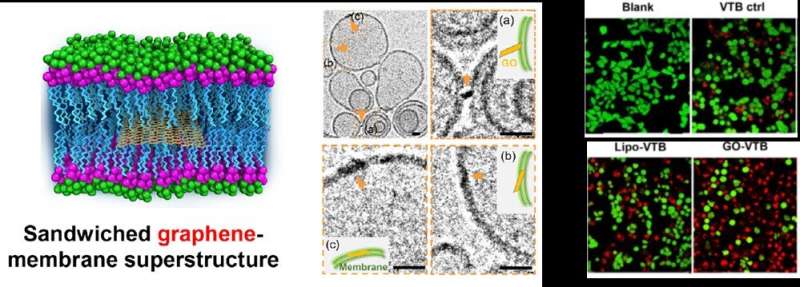Proof of sandwiched graphene-membrane superstructure opens up a membrane-specific drug delivery mode

Researchers from the Institute of Process Engineering (IPE) of the Chinese Academy of Sciences and Tsinghua University (THU) report a sandwiched superstructure for graphene oxide (GO) that transports through cell membranes. The discovery, published in Science Advances, opens up a membrane-specific drug delivery mode, which could significantly improve cytotoxicity effects over traditional drug carriers.
The transport of nanoparticles at bio-nano interfaces is essential for cellular responses and biomedical applications. How two-dimensional nanomaterials interact or diffuse inside the cell membrane is unknown, thus hindering their applications in the biomedical area.
"The sandwiched graphene membrane is a long-simulated superstructure, but an unproved issue in vitro. We are excited to provide substantial experimental evidence and open an avenue for novel membrane-specific drug delivery," said Wei Wei, a professor from the State Key Laboratory of Biochemical Engineering of IPE.
The formation process of sandwiched GO was visualized in a fully hydrated/native state, and the significant influence on cell roughness, cell fluidity and membrane rigidity was also revealed.
Furthermore, the sandwiched GO induced greater drug entry and quicker diffusion time inside the membrane lipid layer, thus outperforming a typical liposome carrier in anti-cancer efficacy. This feature is also extremely beneficial when delivering vaccine adjuvants (e.g., membrane receptor ligands) for enhanced immune effect, according to Wei.
All the cell interactions, diffusion dynamics and the enhanced efficiency of membrane-specific drug delivery of sandwiched GO were simulated by Prof. Yan Litang from THU.
"It is a very nice study of graphene-membrane superstructures. It discloses different transport regimes, the presence of pores and a number of other potentially interesting features related to these systems," said peer reviewers from Science Advances. "Moreover, they demonstrate the applicability of GOs for drug delivery. Overall, the paper is very timely and tells a good story."
The GO-based sandwiched superstructure offers immense design capabilities that may enable a considerable number of applications for these emerging nanomaterials in the cutting-edge fields of biological and medical science.
More information: "Transport of a graphene nanosheet sandwiched inside cell membranes" Science Advances (2019). DOI: 10.1126/sciadv.aaw3192, advances.sciencemag.org/content/5/6/eaaw3192
Journal information: Science Advances
Provided by Chinese Academy of Sciences



















